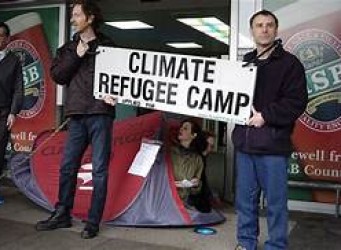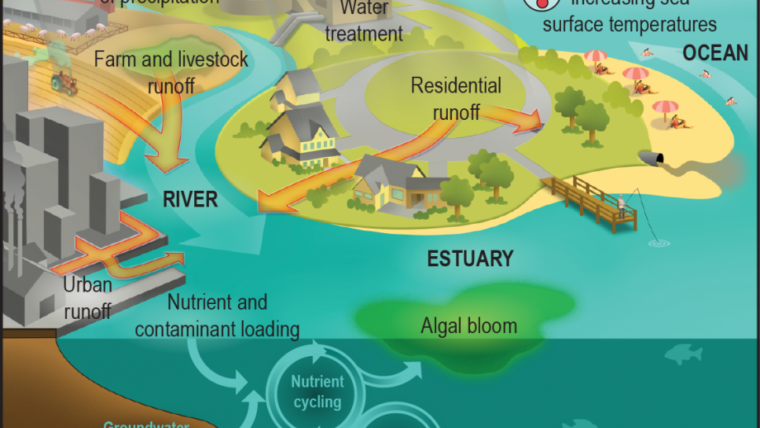I’ve been writing quite a bit about the economic consequences of climate change. Less and less we’re hearing the outcry that doing anything about climate change will have negative, if not devastating impact, on the economy. Besides the fact that there is not ONE study that shows this to be true, actually the opposite, what is overlooked by those that try to perpetrate this myth, is the cost of NOT DOING anything. That cost is increasingly being felt, cha-ching! Hurricane and fire losses are multiplying rapidly as 500 year storms are now happening every few years, if not more often.
The following article from The Hill not only describes the economic loss of permanently displacing people from their homes but also the inequities of this. I’ve posted articles in the past that described climate refugees in other parts of the world. This article brings it home to the U.S. Some of you may be experiencing this occurrence in your own community and you’ll recognize this phenomenon.
“As global climate change progresses, it will eventually lead to ever larger numbers of people being permanently displaced.
So, who is getting displaced? For the wealthy it may be temporary, but for poor folks it could be permanent.”
“Sea level rise and increasingly powerful hurricanes associated with climate change may also prompt climate gentrification. Katrina had that effect in New Orleans, as the wealthy took advantage of the displacement of the poor and purchased their properties. Also, as life along the coast becomes more difficult with disruptions from storms and nuisance flooding, the wealthy may push out entire low-income communities built at higher elevations.”
“We must prepare ourselves for a future in which we will have to accommodate millions displaced by sea level rise, floods, ever-harsher hurricanes, and other damaging effects of climate change. Inevitably, we must recognize evacuees fleeing from storms and sea level rise as what they really are: climate refugees.”
The global climate refugee crisis has already begun
BY ORRIN H. PILKEY AND KEITH C. PILKEY, OPINION CONTRIBUTORS
09/29/18
THE VIEWS EXPRESSED BY CONTRIBUTORS ARE THEIR OWN AND NOT THE VIEW OF THE HILL
When Hurricane Florence struck the shores of North and South Carolina and Virginia, more than a million evacuees fled their homes seeking shelter from the storm. For some, there will be no return home, as their homes are damaged beyond repair or beyond what they can afford to repair. All these displaced people are not simply evacuees fleeing a dangerous hurricane. They are climate refugees.
There are a couple of reasons why climate change is creating a new category of refugee. First, climate change contributes to rising seas. As ocean water warms, it expands. That, along with simultaneous increased melting of the world’s mountain glaciers and the Greenland and Antarctic ice sheets, contributes to rising sea levels. Sea level rise is already one factor producing climate refugees around the world.
Second, climate change contributes to stronger hurricanes. The warming atmosphere transfers heat to ocean water, which in turn transfers heat to storms. This strengthens and expands the storms. Because warmer water evaporates more readily, it also results in greater amounts of rainfall. In 2017, Hurricane Harvey dropped 60 inches of rain on Texas, a U.S. record. And Hurricane Florence’s 30 inches of rainfall was the worst on record for North Carolina, creating massive flooding in the eastern part of the state. The fact that Houston, Texas, has had three “500-year” storms in three years is yet more evidence that we are in an intense and still unpredictable climate era. And each time one of these record-breaking storms strikes, another wave of people must uproot to flee damaging winds, waves, and floods.
The global climate refugee crisis has begun. We are already seeing some permanent displacements of people who don’t return home because their home is destroyed or their farmlands are compromised or they’ve learned a lesson. As global climate change progresses, it will eventually lead to ever larger numbers of people being permanently displaced.
So, who is getting displaced? For the wealthy it may be temporary, but for poor folks it could be permanent. For many in New Orleans, particularly African-Americans, the Hurricane Katrina exodus in 2005 was permanent and they became refugees in the classic sense. Funds for their seriously damaged homes were insufficient for many in low-income neighborhoods to repair extensive flood-related damage. Many fled to Houston, Texas, where at least 20,000 of them experienced Hurricane Harvey.
Sea level rise and increasingly powerful hurricanes associated with climate change may also prompt climate gentrification. Katrina had that effect in New Orleans, as the wealthy took advantage of the displacement of the poor and purchased their properties. Also, as life along the coast becomes more difficult with disruptions from storms and nuisance flooding, the wealthy may push out entire low-income communities built at higher elevations. This is the likely fate of areas such as Little Haiti, which sits on an elevated ridge in Miami. The present residents are finding themselves priced out of the market as wealthier people gobble up the comparatively safe, higher elevation properties.
Meanwhile, every major storm produces climate refugees. For example, after Hurricane Matthew flooded the small eastern South Carolina town of Nichols in 2016, 100 families — a third of the town’s population — left, never to return. With Hurricane Florence, the town has flooded again and residents and some businesses evacuated early, with the storm warnings. It remains to be seen what will happen to these people and their town.
Right now, the diaspora is a trickle. But massive flights of climate refugees are likely within this century, especially from vulnerable low-lying locations such as Miami (4 million refugees). Big storms likely will precipitate the exodus.
We must prepare ourselves for a future in which we will have to accommodate millions displaced by sea level rise, floods, ever-harsher hurricanes, and other damaging effects of climate change. Inevitably, we must recognize evacuees fleeing from storms and sea level rise as what they really are: climate refugees.
Orrin H. Pilkey is James B. Duke Professor Emeritus of earth sciences at Duke University’s Nicholas School of the Environment and the author of numerous books about coastal geology. Keith Pilkey J.D. is a coauthor with Orrin of the forthcoming book “Sea Level Rise Along America’s Shores: The Slow Tsunami.”



